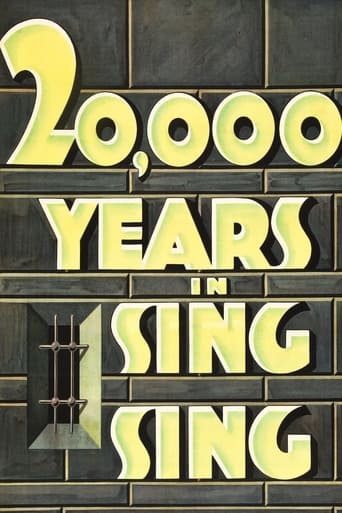

Masterful Movie
... View Moregood back-story, and good acting
... View MoreIt really made me laugh, but for some moments I was tearing up because I could relate so much.
... View MoreThe tone of this movie is interesting -- the stakes are both dramatic and high, but it's balanced with a lot of fun, tongue and cheek dialogue.
... View MoreI watched this movie for the first time last night. I was blown away by the acting of Tracy and Arthur Byron (who plays the warden at Sing Sing). Byron has a commanding voice (he was a famous stage actor) and it is well used here. Director Curtiz obviously liked him because Byron gets a lot of screen time. There are a lot of reaction shots from Byron and Curtiz lets the camera linger on him - his thoughtful face fills the screen. Bette Davis is surprisingly feminine and very sexy. Her characters got edgier later in her career. Here she is very attractive and interesting to watch. The acting from the other supporting actors is not very good and the script is bad. The script simply does not make sense in places. Rockcliffe Fellowes plays Tracy's friend near the end of the picture. Fellowes was the excellent star of 1915's Regeneration (Raoul Walsh dir.)but his career nosedived in talkies. He is worth seeing. If you like pre-Code drama this is definitely worth a look.
... View MoreThis movie may have been released decades ago but its theme resonates today. Although the story is presented in a stagy and melodramatic manner, that in no way negates its power as a tragedy. The movie depicts the wasting of human potential. It's about pent up anger that distorts one's conduct. It's about the institutionalization and dehumanization of the individual. The social message is clear: anyone who winds up in prison is doomed. The principal character, Tommy O'Connor, played by Spencer Tracy, symbolizes all the troubled, angry, alienated and damaged people for whom the only solution is incarceration. Betty Davis plays his loyal girlfriend. Yet, as the movie so aptly shows, even someone deemed incorrigible is capable of acting responsibly and even honorably if treated with compassion. Tracy gives a convincing performance as a cynical and hard-bitten gangster who redeems himself, but at a high cost. To find out what that high cost entails, watch the movie.
... View MoreThe very same year that Barbara Stanwyck went up the river in "Ladies They Talk About", Spencer Tracy took the Metro North up to Sing Sing. He's guilty of many heinous crimes, and has a 5-30 year stretch for a robbery charge with assault and battery. But if Tracy has his way, his "visit" to Sing Sing will have him whistling a happy tune. He doesn't count on warden Arthur Byron stepping on his toes, turning down his crooked attorney's (Louis Calhern) request for special treatment. After months of confinement in his cell (having been told he'd be longing for the rock pile), Tracy gets out, grabs his sledge hammer, and is happy to finally see the light of day. Eventually, his better behavior lands him a job working in the shoe department.When Calhern begins to put the moves in on Tracy's gal (a young Bette Davis), Tracy plots his breakout, but of course, it happens on Saturday, which he considers his "unlucky" day. The warden, trusting Tracy, gives him a temporary leave when he learns that Davis has been in a car accident and will probably not survive. Tracy intends to return (even if facing execution), but is involved in a murder, and the warden faces the wrath of the press and considers resigning his job.This prison drama doesn't totally sugarcoat conditions in the penal system, but something tells me that even in Pre-Code Hollywood, there was more going on at Sing Sing than what is presented here. An honest warden, strict but essentially kindly guards, and the privilege of temporary leaves made me a bit cynical. Still, when you've got an actor like Tracy, a rising star like Davis, some sizzling dialog, and tight direction by Michael Curtiz, the result is a cracking crime drama that made Warner Brothers movies the most realistic and gritty before that nasty production code come along and took the sass out of their sails.
... View MoreThis movie is a tame, toothless wannabe prison/crime drama that doesn't hold a candle to its pre-Code siblings such as Scarface, Little Caesar, and Public Enemy, to name a few. I was quite disappointed.The movie starts out promising enough, with Spencer Tracy as a hardened tough guy being hauled off to Sing Sing. The problem with this movie is that is was really all over the map -- it didn't pick one genre and stick to it. At times it was a crime flick (or was pretending to be), at other times a light-hearted comedy, at other times a buddy flick (with the prison warden and Tracy being the buddies, no less!). The actors did well with their individual roles (including a very young and beautiful Bette Davis) and the story moved fairly apace, but in the end it added up to a whole lot of nothing for me.To top it off, there were some inconsistencies and/or hard-to-follow plot developments that bothered me: 1 - During a psychological test session to determine which manual labor to place the prisoners in, Tracy and Lyle Talbot do good enough on their puzzle to earn the "shoe shop" (top of the line job at the prison, according to the story), but dolt Hype can't fit the square piece into the square slot even after 5 minutes, so he is assigned lavatory duty. However, minutes later when we see the boys toiling away in the shoe shop, there's Hype too! 2 - While on his honor leave, Tracy decides he needs to get out of town rather than returning to prison. He talks to one of his buddies to make arrangements to leave on a train, and even hands over $5,000 to help grease the wheels and make the escape happen. Then, a scene or two later, we see Tracy showing back up at prison. What gives? 3 - The whole business with Tracy's lawyer and his girlfriend and the $5,000, I just didn't understand it. The movie tried to explain it but either they did a really bad job of it, or there were things going on in 1932 that you just had to be there to understand it (and hence my 2005 mind didn't quite catch), or I'm as big of a dolt as Hype. (I prefer not to think it's the latter!) Overall, it was fun to watch Tracy and Davis early in their careers, but honestly wasn't really worth having to sit through this movie in order to do so.
... View More